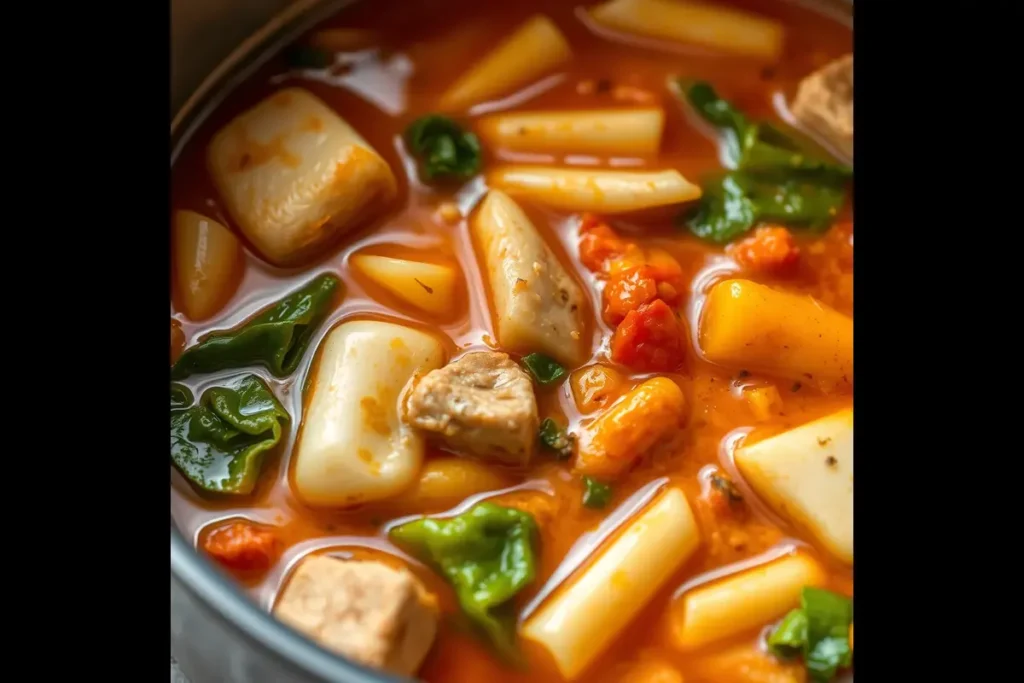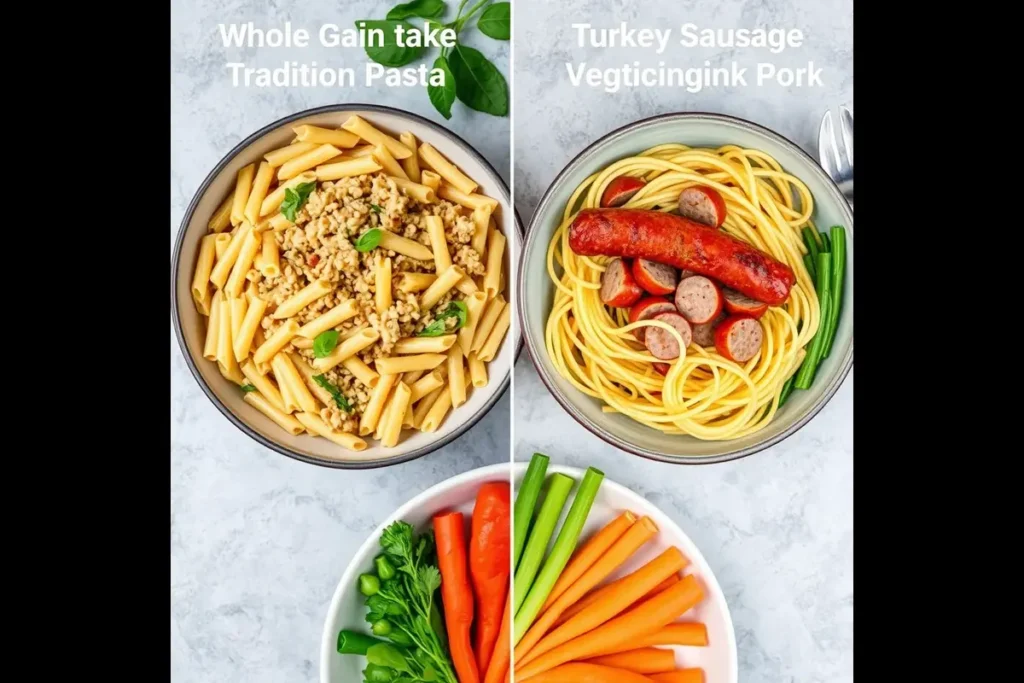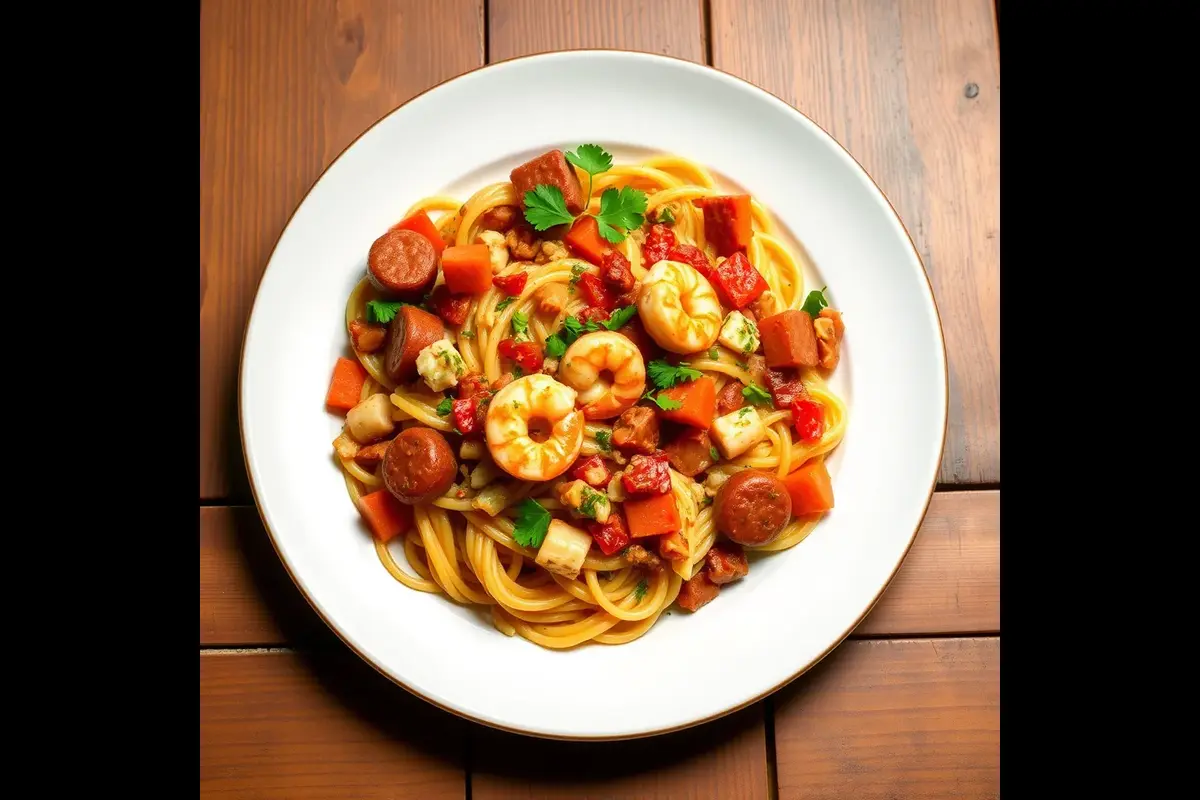Is Pastalaya Healthy? A Comprehensive Guide
Cajun cuisine is renowned for its bold flavors, and pastalaya is no exception. Combining the rich essence of jambalaya with pasta, this dish is a favorite among many. But when it comes to health, the question arises—is pastalaya healthy? In this guide, we’ll explore the nutritional profile of pastalaya, its potential health benefits and drawbacks, and how to make it a healthier choice without sacrificing flavor.
Part 1: Nutritional Composition of Pastalaya
What’s in a Typical Bowl of Pastalaya?
Key Ingredients and Their Nutritional Profiles
Pastalaya typically includes a blend of pasta, proteins like sausage, chicken, or shrimp, and vegetables such as onions, celery, and bell peppers—the Cajun “Holy Trinity.”
- Proteins: Sausage provides flavor but can be high in saturated fats and sodium. Chicken and shrimp are leaner, offering high protein with fewer calories.
- Vegetables: These add fiber, vitamins, and antioxidants, making the dish more nutritious.
- Pasta: Often made with refined flour, it contributes carbohydrates and calories but lacks fiber unless whole-grain options are used.
Caloric Content of a Standard Serving
On average, a single serving of pastalaya contains between 400-600 calories, depending on the recipe. This makes it a moderate-calorie dish, though portion size and additional ingredients can quickly increase the count.
Vitamins and Minerals
Pastalaya provides essential nutrients, including vitamin C from bell peppers, potassium from celery, and protein from the meats. However, the dish may lack calcium or iron unless fortified or supplemented with nutrient-dense sides.
Part 3: Health Benefits of Pastalaya

Positive Aspects of Eating Pastalaya
High Protein Content
One of the key benefits of pastalaya is its high protein content. With ingredients like sausage, chicken, and shrimp, the dish offers a mix of complete proteins that are essential for muscle repair and growth.
- Sausage: While higher in fat, sausage adds significant flavor and protein. Opting for leaner varieties like turkey sausage can reduce fat without compromising taste.
- Chicken and Shrimp: Both are lean protein sources, with shrimp adding omega-3 fatty acids, which support heart health.
Nutrient-Dense Vegetables
The Cajun “Holy Trinity” of onions, celery, and bell peppers is not only flavorful but also rich in vitamins and antioxidants.
- Onions: Provide vitamin C and compounds that support immune health.
- Bell Peppers: A powerhouse of antioxidants, including beta-carotene and vitamin A.
- Celery: Adds fiber and potassium, helping with digestion and electrolyte balance.
Customizable for Dietary Needs
Pastalaya is a versatile dish that can be adapted to various dietary preferences:
- Gluten-Free Options: Substitute traditional pasta with gluten-free alternatives made from lentils, quinoa, or brown rice.
- Lean Proteins: Use chicken breast, turkey sausage, or plant-based proteins to lower fat content.
- Low-Carb Variants: Replace pasta with spiralized zucchini or spaghetti squash for a lighter version.
Balanced Macronutrient Profile
When prepared thoughtfully, pastalaya offers a harmonious mix of carbohydrates, proteins, and fats. This balance provides sustained energy and helps keep you fuller for longer. Including more vegetables can further enhance the nutrient density without adding excessive calories.
Part 4: Potential Drawbacks of Pastalaya
Challenges in Calling Pastalaya Healthy
High Sodium Levels
Sausage, seasoning blends, and broth contribute significant sodium to pastalaya. High sodium intake can lead to health issues such as high blood pressure.
- Sausage: Often contains added salt and preservatives.
- Seasonings: Cajun blends may be rich in sodium unless homemade or low-sodium alternatives are used.
- Broth: Using store-bought broth can add hidden salt; opt for low-sodium versions to reduce intake.
Calorie Density
The combination of pasta and sausage makes pastalaya a calorie-dense dish.
- Pasta: Provides a high carbohydrate load, which can lead to weight gain if consumed in excess.
- Sausage and Oils: Add fat and calories, making portion control essential for a balanced diet.
Saturated Fat Concerns
Saturated fats, primarily from sausage and cooking oils, can contribute to heart disease if consumed in large amounts.
- Swap traditional sausage with turkey or chicken sausage.
- Use olive or avocado oil instead of butter or heavier oils to cut down on unhealthy fats.
Portion Control Issues
The rich flavors of pastalaya can make it easy to overeat, especially in social settings where large servings are common.
- Use smaller plates to help with portion control.
- Pair with light, fiber-rich sides like salads to fill up without consuming extra calories.
Part 5: Making Pastalaya Healthier

Tips for Healthier Pastalaya Recipes
Choosing Leaner Proteins
Switching to leaner proteins is one of the easiest ways to make pastalaya healthier.
- Turkey Sausage: Offers the same smoky flavor as traditional sausage but with less fat and fewer calories.
- Chicken Breast: High in protein and low in saturated fat, it’s a versatile and heart-healthy choice.
- Plant-Based Options: Tofu, tempeh, or plant-based sausages can provide a protein boost while catering to vegetarian or vegan diets.
Using Whole-Grain or Gluten-Free Pasta
Replacing regular pasta with healthier alternatives can increase the dish’s fiber content and reduce its glycemic impact.
- Whole-Grain Pasta: Adds fiber and nutrients like B vitamins and iron, supporting digestive health.
- Gluten-Free Pasta: Made from quinoa, chickpeas, or lentils, these options are perfect for those with gluten sensitivities and often contain more protein.
Reducing Sodium
To cut down on sodium without sacrificing flavor:
- Low-Sodium Broths: Swap regular broths for low-sodium or homemade versions to control salt content.
- Homemade Seasoning Blends: Create your own Cajun spice mix using herbs and spices like paprika, garlic powder, and thyme.
- Fresh Ingredients: Using fresh proteins and vegetables reduces reliance on processed items that are often high in salt.
Adding More Vegetables
Boosting the veggie-to-pasta ratio not only increases the nutrient density but also adds volume to the dish, making it more filling.
- Additional Vegetables: Consider adding zucchini, spinach, or mushrooms for more vitamins and minerals.
- Veggie Swaps: Replace half the pasta with spiralized vegetables or cauliflower rice for a lower-calorie option.
Part 6: Comparing Pastalaya to Other Dishes
Is Pastalaya Healthier Than Jambalaya?
Both pastalaya and jambalaya share similar ingredients and flavors, but their health profiles can differ.
- Calorie Content: Jambalaya, made with rice, typically has fewer calories than pasta-based pastalaya, depending on the portion size.
- Carbohydrates: Rice in jambalaya is less processed than traditional pasta but contains fewer nutrients compared to whole-grain options.
- Fats: Sausage and cooking oils contribute saturated fats in both dishes, though using lean proteins can reduce this in pastalaya.
Pastalaya vs. Other One-Pot Meals
When compared to other one-pot dishes like pasta primavera or fried rice:
- Pasta Primavera: Often lighter, with a focus on vegetables and olive oil, making it a lower-calorie option.
- Fried Rice: Can be high in calories and sodium due to soy sauce and added oils, but using brown rice or reducing oil can make it healthier.
- Pastalaya: Offers a more balanced macronutrient profile, especially when prepared with lean proteins and whole-grain pasta.
Part 7: Frequently Asked Questions (FAQs)
FAQs About the Healthiness of Pastalaya
Can Pastalaya be part of a healthy diet?
Yes, pastalaya can be part of a healthy diet when prepared mindfully. Balance is key: use lean proteins, whole-grain pasta, and add plenty of vegetables to boost the dish’s nutritional profile. Limiting high-sodium ingredients like pre-packaged sausage and seasoning blends can further enhance its healthiness. Enjoy it in moderation, pairing it with light, fiber-rich sides like salads or roasted vegetables for a well-rounded meal.
Is gluten-free pastalaya as healthy as regular?
Gluten-free pastalaya can be just as healthy, if not healthier, depending on the type of pasta used. Gluten-free options made from chickpeas, lentils, or quinoa often contain more protein and fiber than traditional refined pasta. However, some gluten-free pastas may be lower in nutrients and higher in calories, so check labels to choose the most nutritious variety.
How many calories are in a serving of pastalaya?
The calorie content of pastalaya varies widely based on ingredients and portion size. On average, a serving contains 400-600 calories. Using whole-grain pasta, lean proteins, and reducing added oils can bring this number down. Adding extra vegetables not only boosts nutrients but also lowers calorie density, making the dish more filling without additional calories.
What are good substitutes for high-fat ingredients?
To reduce fat content in pastalaya, try these swaps:
- Use olive oil or avocado oil instead of butter for cooking.
- Replace pork sausage with turkey sausage or plant-based alternatives.
- Substitute heavy cream with low-fat milk or a dairy-free alternative like unsweetened almond milk for creamy variations.
Part 8: Conclusion
Finding Balance with Pastalaya
While pastalaya may not be inherently healthy, it can certainly be part of a balanced diet with a few thoughtful adjustments. Lean proteins, whole-grain pasta, and plenty of vegetables can elevate its nutritional value, while reducing sodium and saturated fats make it a more heart-friendly choice.
The key is moderation and creativity in your preparation. By making mindful ingredient choices and pairing pastalayawith light sides, you can enjoy this flavorful Cajun classic without compromising on health. After all, healthy eating is about balance, not restriction. Enjoy your bowl of pastalaya guilt-free!

